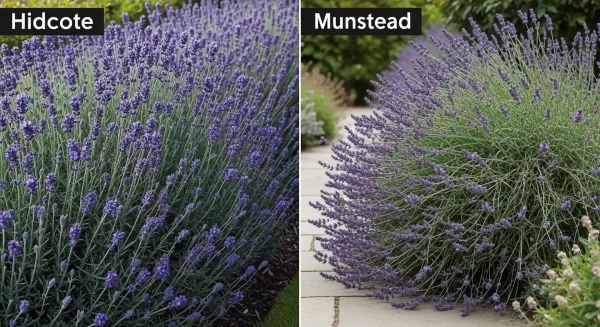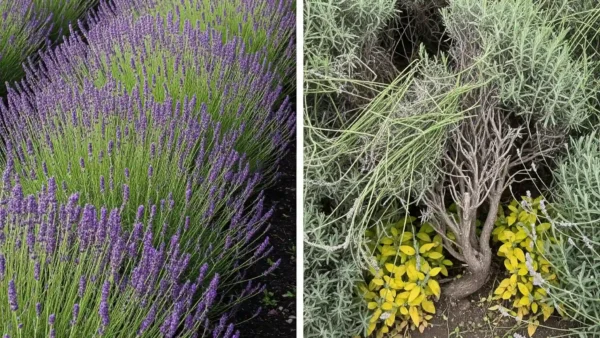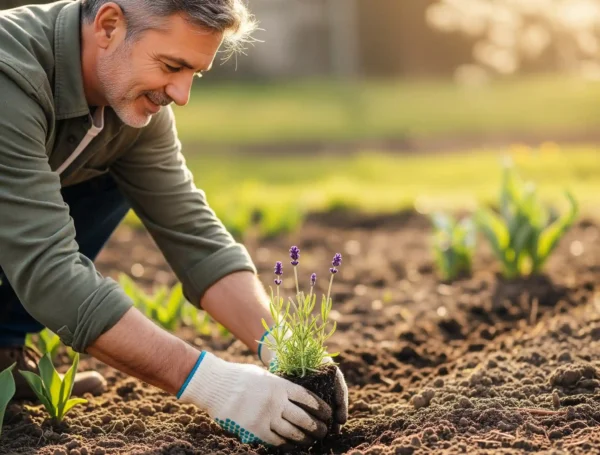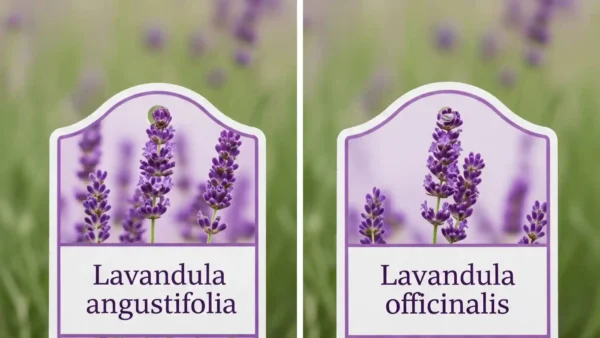Thirsty or doing well? The Gardener’s Complete Guide to Watering Lavender
It’s the conundrum that every gardener has faced: they killed a plant by accident, even if they meant well. You enjoy your lavender because of its peaceful smell, its silver leaves, and its veil of purple blossoms. You want to take care of it and give it everything it needs to grow. So you give it water, which is the source of all life. And then, sadly, you see its leaves turn yellow, its stems droop, and it slowly dies.
TL;DR: The Lavender Watering Code
- The Golden Rule: The most important thing to remember when watering lavender is to do it deeply and not very often. Let the soil dry out entirely between waterings.
- The #1 Killer is Overwatering: More lavender is killed by too much kindness (water) than by neglect. The plant is built for dry conditions and hates having “wet feet,” which leads to fatal root rot.
- How to Check for Thirst: Don’t guess, test!
- The Finger Test: Stick your finger two inches into the soil. If you feel any moisture, do not water.
- The Chopstick Test: Insert a wooden chopstick deep into the soil. If it comes out clean and pale, it’s time to water. If it’s dark or has soil clinging to it, there’s still moisture deep down.
- Signs of Trouble:
- Overwatering: Leaves turn yellow from the bottom up, stems feel soft or mushy, and the soil smells musty. The plant wilts despite being in wet soil.
- Underwatering: The newest growth at the tips wilts first, and the leaves feel dry or crispy. The soil will be bone dry. An underwatered lavender is almost always easier to save than an overwatered one.
- Watering Schedule:
- Newly Planted: Water deeply about once a week for the first month to help it establish.
- Established Plants (Year 2+): Water deeply only every 2-3 weeks during the hottest, driest parts of summer. You may not need to water at all if you get regular summer rain. Stop watering completely in the fall and do not water during winter dormancy.
You are not alone if this story hits home for you. An obsessive gardener kills more lavender plants than anything else. Everyone is confused about how to water this gorgeous yet picky plant. But the key to success is surprisingly simple and demands a big change in the way we think.
The most important thing to remember when watering lavender is to do it deeply and not very often. Let the soil dry out entirely between waterings. It is a plant that does well when you don’t pay attention to it and hates having “wet feet.”
The hardest part, and the reason for most mistakes, is telling the difference between a plant that is thirsty and one that is drowning, since they might seem very similar. This Lavender Watering Guide will not only show you how to water your plants appropriately, but it will also teach you how to read the subtle signals your plants give you. This will change you from a worried waterer to a confident and intuitive gardener who knows how to speak lavender.
Do you want to know the difference between a plant that is thirsty and one that is drowning? Let’s go nasty.
Why Lavender Doesn’t Like Wet Feet: Think Like a Mountain
You need to forget that lavender is in your garden before you can really learn how to water it. Get rid of the pictures of verdant lawns and thirsty petunias. Instead, think of its ancient habitat, the rocky, sun-baked, and windy hills of the Mediterranean. This isn’t simply a pretty picture; it’s a plan for growing plants that teaches us all we need to know.
A Plant Made for Dry Weather
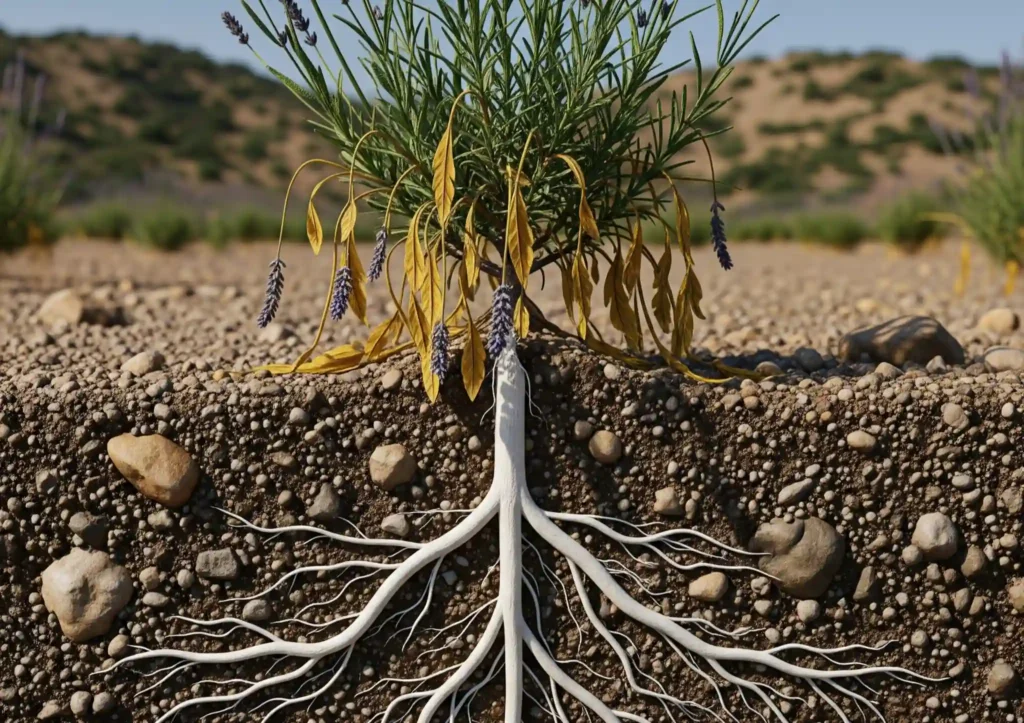
Over thousands of years of surviving hot, dry summers, lavender’s whole structure has become a work of art in water conservation. The plant’s famous silver-green leaves are covered in fine, downy hairs (an indumentum) that accomplish two things very well: they reflect the harsh sunlight to keep the plant cool, and they trap a thin, humid layer of air just at the leaf’s surface, which keeps the plant from losing moisture through evaporation. It has a deep, strong, searching taproot that doesn’t sit in surface moisture but instead goes deep into stony, gravelly soil to find rare water sources in deep cracks. It is genetically programmed to not only survive, but also do well in conditions that would kill most other garden perennials. It expects and even likes times when it is dry.
The Study of Root Rot
Lavender’s roots need oxygen to live, which is also what kills it in our rich, often-irrigated gardens. Plant roots don’t just take in water; they also need to breathe in oxygen from the little air pockets that are found in healthy, well-structured soil. These air pockets fill with water when the earth is always moist or saturated. The roots actually start to choke. Their cells die and they start to rot, turning into a brown, mushy, frequently foul-smelling mess that is attacked by anaerobic bacteria that thrive in low-oxygen environments.
This is the horrible irony that so many gardeners can’t understand: these roots that are rotting can’t take in water, no matter how much you give them. The plant above ground starts to wilt and its leaves droop, as if it is thirsty. The gardener, who means well, gives it even more water since they think they are helping. This last gesture of generosity speeds up the rot, drowns the last few healthy roots, and seals the plant’s doom.
How to Water: A Guide for Every Stage
Knowing why lavender likes it dry helps us come up with a watering schedule that works with the plant’s nature instead of against it. This is a dance of giving just enough and then showing how smart it is to walk away.
For Lavender That Was Just Planted (The First Month)
A new plant, even if it can handle drought, is like a baby; it requires some extra care while it settles into its new environment. The root system is still limited to the initial root ball for the first few weeks following planting. You want to give it just enough water to stay alive while also helping the new roots develop into the natural soil around it.
Once a week, water the base of the plant deeply. You might need to do this twice a week if the weather is really hot (above 90°F) and windy. The most important thing is to allow the top inch or two of soil dry out a little bit between waterings. You don’t want the soil to stay wet all the time, but you also don’t want a new plant that hasn’t grown yet to dry out completely and die. This stage is a short-term balance. You’re getting it used to life outside of the nursery and teaching it how to be a strong, independent garden plant.
For Lavender That Has Been Growing for a While (Year 2 and Up)
This is where the skill of “virtuous neglect” really starts. A lavender plant that has been there for a while and has a deep, wide root system that has spread out into the soil around it can handle dry conditions very well. The weather and the soil should decide when you water your plants, not the calendar.
Method: In most places, an established lavender plant only needs a deep soaking every two to three weeks during the warmest, driest stages of summer when there hasn’t been much rain for a long time. This is not something you do every week. If you get a lot of rain in the summer, like a strong thunderstorm every week or two, you might not need to add any extra water from June to September.
The Deep and Rare Method
This is the most crucial thing to remember for the health of your lavender in the long run. Don’t ever give your lavender a shallow, everyday spritz from the hose. This is the worst thing you could do. It makes the plant’s roots grow close to the surface, where they are shallow, indolent, and reliant. These roots are sensitive to heat and dry out first, which makes the plant less able to handle drought. You should water deeply instead to get the roots to dig down into the colder, deeper soil where moisture stays for longer.
How to do it: Use a watering can with a “rose” attachment (the head that looks like a sprinkler) or a soaker hose that goes around the plant’s base. For a few minutes, carefully and gently apply water. You don’t just want to wet the surface; you want to feel like you’re getting the root zone wet all the way down to 6 to 8 inches into the soil. Think about filling up a reservoir that the plant can use for weeks. Then, leave. Don’t water again until the ground is completely dry.
The Gardener’s Eye: How to Tell if Your Plants Are Thirsty
Don’t worry about watering on a timetable. A Tuesday that is hot and windy is very different from one that is cool and cloudy. Listen to your plant and your soil. Here are three ways, from the simplest to the most complicated, to know for sure when it’s time to water.
The Test of the Finger
This is the easiest, most classic, and most dependable way. Don’t be scared to get a little dirty. Put your index finger into the dirt up to your second knuckle, not precisely at the stem, but at the edge of the plant’s drip line, where the leaves terminate.
The verdict: Don’t water if you feel any moisture at all, even a little chill or wetness. Get out of here. You can stop working now. It’s time to give it a deep, gratifying drink if it feels entirely dry, dusty, and even warm to the touch.
The Golden Knuckle Trick with Chopsticks
If you want to get a better and more accurate reading, especially in bigger pots or raised beds where the surface may look dry but isn’t, use this approach from orchid growers. Carefully drive a simple, unfinished wooden chopstick or a long bamboo skewer as deep as you can into the dirt near the plant. Don’t poke the main root ball. Let it sit for a minute so it can soak up any extra moisture.
The Verdict: Take it out and look at it. If it comes out dark and has wet dirt on to it, that means there is a lot of moisture deep down where it matters, even if the top is dry. The whole root zone is thirsty if it comes out clear, pale, and absolutely dry.
The Pot Weight Method for Containers
This is the easiest and most accurate technique to tell when a container plant needs water. Once you get the hang of it, you’ll use it for all your potted plants. It takes some time to become used to calibrating your senses, but it quickly becomes second nature.
The Verdict: Pick up your potted lavender right after you’ve watered it well enough that water runs out the bottom. Feel how heavy it is. This is the most weight it can hold. After then, pick it up again a week later. A pot full of dry dirt will feel much, much lighter than you expect. The difference in weight is the best evidence that the water has run out.
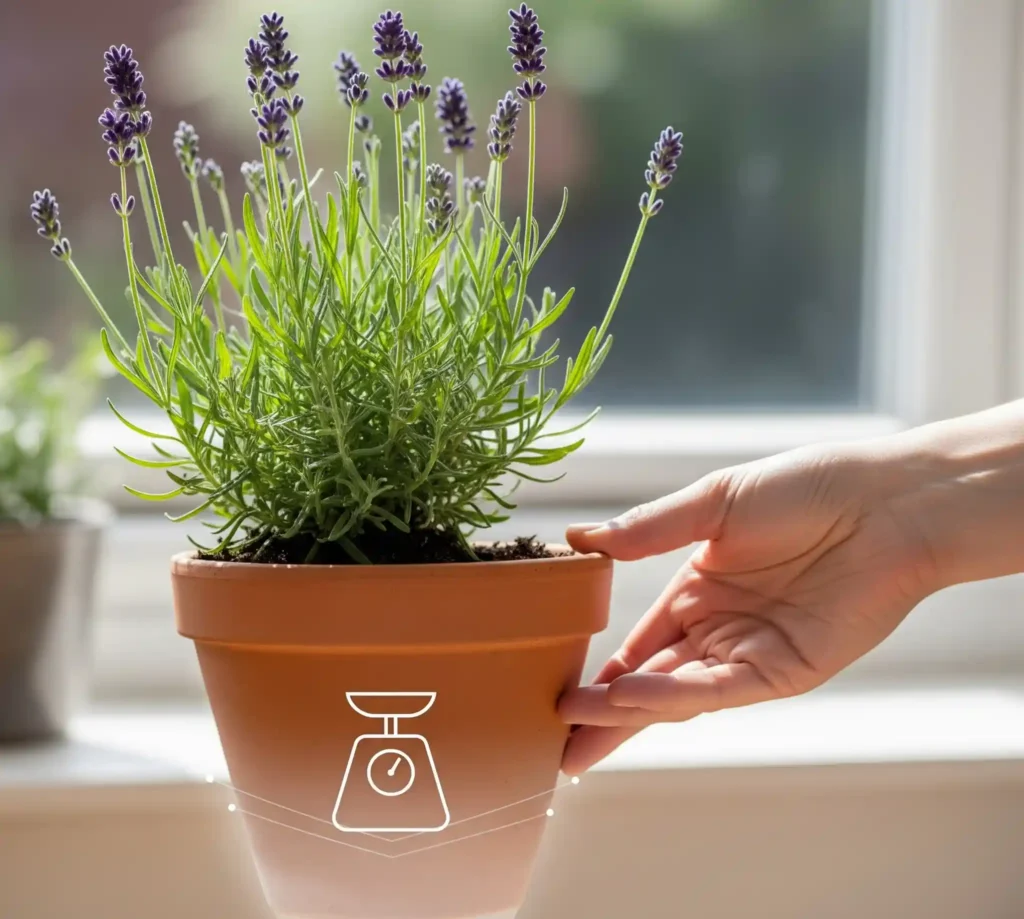
Watering All Year: From the Heat of Summer to the Dormant Winter
Like the plant, your watering schedule needs to change with the seasons.
Summer Heat: When there are really hot days, your lavender may look a little limp or wilted in the late afternoon. This is a natural defense mechanism termed transpiration, in which the plant seals its pores (stomata) to keep water during the warmest part of the day. Don’t freak out and grab the hose! First, look at the dirt. It does need water if the soil is really dry. Water deeply between 6 AM and 9 AM in the early morning. This lets the plant stay fully hydrated before the heat of the day, cuts down on unnecessary evaporation, and, in humid locations, makes sure the leaves are dry by nighttime, which stops fungus from growing.
Winter Care: This is where a lot of northern gardeners go wrong. As the weather gets cooler in the fall, your lavender will need a much less water. Slowly cut back on how often you water. Once the steady fall rains start, you should stop watering plants that are in the ground in most climes (Zones 5-8). The plant has to be dry when it goes into winter. The cold itself isn’t as bad as wet winter soil and frigid temperatures. Don’t water lavender that isn’t growing in the winter.
The rules are the same for pots and in-ground plants, but the frequency changes. Plants in terracotta pots dry up considerably faster than plants in the ground because they are exposed to dry air on all sides and have a small amount of soil. If it doesn’t rain for a time in the summer, a plant in the ground might need water every two to three weeks, but a plant in a pot might need water every seven to ten days. The best ways to test are with your finger, chopstick, or pot weight.
Diagnosing and saving your plant with lavender ER
It happens to everyone. You gave it too much water. Let’s learn how to figure out what’s wrong and how to help in an emergency.
A visual guide to overwatering and underwatering
They can both look wilted, but the other signs are completely different. A gardener’s superpower is knowing this difference.
- Signs of too much water: The whole plant, from the bottom up, will start to turn yellow. The leaves will feel soft, floppy, and almost mushy, not crisp. The plant may be drooping, but the soil will feel damp or wet. This is a wilt from rotting and suffocating, not from being thirsty. At the base of the plant, you could also smell something musty and marshy. When you touch the leaves, they fall off effortlessly.
- Signs of underwatering: The newest, softest growth at the tips and tops of the stems will wilt first. The leaves will seem a little gray and feel dry or crunchy when you touch them. The lowest leaves, which are older, will probably stay silver and strong. The ground will be rather dry deep below. The leaves will stay tightly attached to the stems.

How to Save a Lavender That Has Been Overwatered
- Stop watering right away. This is the first, most vital, and most obvious thing to do. Don’t give it another drop. Your goal now is to help things dry.
- Make the air flow better. If other plants are crowding the lavender, you could want to tie them back or even cut them back for a while to let more sun and air reach the base of the lavender. This will help the soil dry up.
- For potted plants, this is your best chance of success (the emergency repot). Carefully pull the plant out of its pot. Look at the roots. Don’t be shy. Roots that are healthy are white and strong. Roots that have rotted will be dark, black, mushy, and maybe even smell bad. Use a clean, sharp pair of scissors to cut off any and all rotten roots. Be tough; you’re doing surgery to save its life. After that, put it in a clean terracotta pot with new, thoroughly dry, granular lavender soil. Don’t use the old, wet soil again. Don’t give it water for a few days. Give it time to get over the shock.
- For plants that grow in the ground, you have fewer choices and need to be patient. Wish for a long, dry, sunny time. If your soil is heavy clay, this event is a clear warning that the area isn’t good for growing plants. The best thing to do is to wait until next spring, carefully dig out the plant, and replant it in a raised bed, on a mound, or anywhere else where you have improved the soil for greater drainage.
In conclusion
It’s not about planning when to water lavender; it’s about paying attention. It’s about not wanting to pamper the plant and instead realizing that this sun-loving plant, which grows on parched mountain slopes, is more afraid of drowning than it is of being thirsty. Your goal is to give your plants deep, infrequent drinks that help them grow strong, deep roots that can survive any storm or drought.
Don’t water if you’re not sure. First, look at the dirt. You can nearly always save a dry lavender plant, but you can’t save a rotten one. You can finally put down the hose and learn how to give your lavender just what it needs to grow for years to come with this Lavender Watering Guide.
Questions that are often asked
I just put my lavender in the ground. How often do I need to water it?
Water it well once a week for the first two to three weeks, or twice a week if it’s really hot and windy. You should keep the soil slightly damp so that the plants may grow their roots, but not so wet that it stays that way all the time. You can start to lengthen the period between waterings and switch to the deep and infrequent approach for established plants after approximately a month, when you observe signs of new growth.
Should I give my lavender water in the winter?
No. If you live in a place where the ground freezes or you get winter rain, you shouldn’t water dormant plants that are already in the ground from late fall to spring. The cold and wet weather in winter is its worst adversary. If you bring potted plants into an unheated garage for dormancy, a small amount of water once a month will keep the roots from drying out completely and turning to dust.
I just watered my lavender, but it’s still wilting! What’s going on?
This is the classic indicator of overwatering and root rot that is sad. The roots are hurt and can’t take in the water you’re giving them, so the plant is wilting even though it’s in wet soil. Don’t give it any more water. Stop watering right away, check the soil to make sure it’s wet, and then follow the methods in the “Lavender ER” section to try to rescue it.
Does lavender need more water to bloom more?
No, this is a prevalent myth. At least six to eight hours of full, direct sun and correct trimming are the most important things that make flowers grow. A very dry plant won’t bloom well, but giving a healthy lavender more water won’t make it bloom more. Instead, it will probably grow weak and floppy and have a far higher chance of getting root rot.



